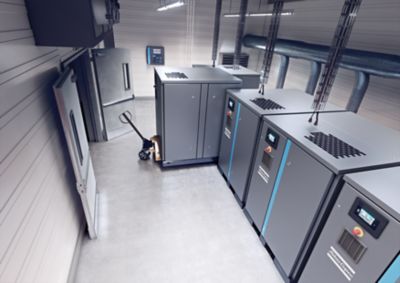What air treatment equipment is recommended for industrial compressors?
Accessories such as filters and dryers have an essential role to play in optimising the quality of compressed air. This is because they remove contaminants such as dust, oil and other liquids that could negatively affect end products or processes and impact profitability.
Reading time: 5 minutes (1000 words)
They’re also important from an economic point of view, with air treatment equipment typically accounting for 35 per cent of a company’s capital spend on an entire compressed air system, and the remaining 65 per cent going to the cost of compressors themselves. For these reasons, it’s vital to choose the right type of air treatment equipment that will enhance a compressed air system and reduce total cost of ownership.
Should I get an oil-free compressor?
If 100 per cent avoidance of oil contaminants is needed, for example in sensitive applications in the food processing, electronics and pharmaceutical sectors, then an oil-free compressor is the best option. This is because no oil is introduced in the process of compressing the air.
Oil-injected compressors use oil as a lubricant during the compression process, while oil-free ones do not
Misconceptions and recommendations for compressed air treatment
Myth: Any kind of dryer is sufficient to ensure there is no moisture in compressed air, regardless of the environmental conditions
Now, let’s take a look at some common misconceptions and recommended tips surrounding compressed air quality and treatment. Firstly, although the majority of industrial sites are right to select a refrigerant dryer to remove moisture from compressed air there are some important exceptions.
Myth: Dropping system pressure can be done at any time, without any other considerations
Another myth is that it’s ok to try and save costs by dropping a system’s air pressure. For example, if a system is designed to operate at 100 psi and the user turns it down to 90 psi to reduce energy consumption. Unfortunately this can have a negative effect on air quality, especially if the air treatment equipment has been sized to handle a higher pressure level. Reducing the pressure level could mean the dryer or filters are now too small and prone to becoming overflowed, leading to them not being able to remove moisture and contaminants effectively.
Recommended: When using carbon filters for sensitive processes, review service intervals
Finally, if oil in vapour form is detrimental to a process, and is being removed by carbon filter, it is recommended to maintain air treatment equipment more regularly. This is because higher ambient summer temperatures can lead to a larger volume of oil vapour in an air supply. However, regular testing will ensure oil vapour does not break through at this stage.
Recommended: Review condensate disposal process
What this goes to show is that air treatment is a vital stage in all compressed air systems, whether an oil-injected or oil-free compressor is used. Determining the quality of compressed air required in the application is the crucial first step, after which it becomes easier to identify and select the appropriate types of air treatment equipment. Ultimately, by making the right choice of air treatment equipment companies can avoid any potential problems relating to contamination. This will help to ensure the consistency of their end products, and can help to reduce total cost of ownership.
About the author
 Andy Lill has an HNC in mechanical engineering. He commenced his career in railway engineering and progressed with service and sales engineering management positions with major manufacturers within the compressed air industry. Lill’s most recent role was with a filtration specialist company.
When not meeting the daily challenges of his new appointment, Lill’s off-duty activities include avid support for Manchester City, cycling, driving his convertible and undertaking DIY projects.
Andy Lill has an HNC in mechanical engineering. He commenced his career in railway engineering and progressed with service and sales engineering management positions with major manufacturers within the compressed air industry. Lill’s most recent role was with a filtration specialist company.
When not meeting the daily challenges of his new appointment, Lill’s off-duty activities include avid support for Manchester City, cycling, driving his convertible and undertaking DIY projects.

